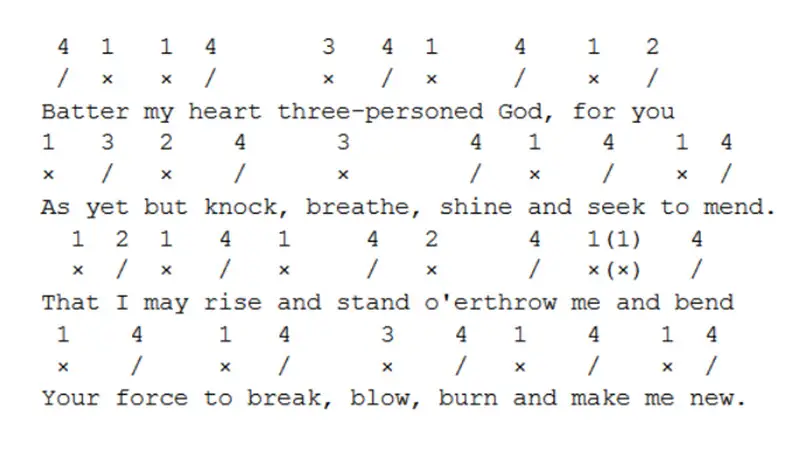Contents
Understanding Iambic Pentameters
If you want to write poetry or you want to be a more careful reader of it, learning these terms will help.
Iambic Pentameter Definition
Lets define some terms to help explain this one. Meter refers to the pattern of syllables in a line of poetry or even an essay.
The most basic unit of measure in a poem is the syllable and the pattern of syllables in a line, from stressed to unstressed or vice versa.
This is the meter.
Syllables are paired two and three at a time, depending on the stresses in the sentence.
Two syllables together, or three if its a three-syllable construction, is known as a foot.
So in a line of poetry the iamb would be considered one foot. Because when you say the words, the is unstressed and iamb is stressed, it can be represented as da DUM.
Pentameter is simply penta, which means 5, meters. So a line of poetry written in pentameter has 5 feet, or 5 sets of stressed and unstressed syllables. In basic iambic pentameter, a line would have 5 feet of iambs, which is an unstressed and then a stressed syllable.
Or said in another way:
Languages possess inherent rhythms resulting from the interplay of the unstressed and stressed syllables as well as contrast between short and long vowel sounds. In the English language, the rhythms are typically analyzed in the context of a verse, whereby the language’s rhythm usually manifests itself in formal patterns, which can be categorized along 2 separate lines.
 The first category is on the basis of the pattern on unstressed and stressed syllable in each line, where “feet” is the term given to the groupings of the syllables.
The first category is on the basis of the pattern on unstressed and stressed syllable in each line, where “feet” is the term given to the groupings of the syllables.
Each foot follows a given pattern, whether unstressed followed by stressed, stressed followed by unstressed, or two syllables that are equally stressed.
“Iambic” is a term used to refer to a particular type of foot, which is an unstressed syllable that is followed by a stressed syllable, as is the case in the word “compare”.
The concept of the iambic meter traces its origins back to classical Latin and Greek poetry, where it is defined by the alteration of short and long syllables.
English verse adopted this framework by replacing the long syllables of classic meter with stressed syllables and the short syllables with unstressed syllables.
Besides the pattern on unstressed and stressed syllables, lines of verse typically have specific lengths. The lengths are expressed as the feet or number of pairs in a particular line. Lines that have five feet are essentially written in “pentameter”.
Iambic pentameter therefore refers to a line with 5 pairs of syllables, where each of the pairs is an iamb that is comprised of a stressed syllable, which is then followed by an unstressed syllable. It is not a must for the syllables to be paired within a particular word, but it can be comprised of 2 words because the English language’s natural inflection is still able to define an iambic rhythm.
In the modern times, iambic pentameter is synonymous with the works of Shakespeare. Shakespeare almost always used iambic pentameter when writing in verse. He wrote most of his famous plays in iambic pentameter, save for the lower-class characters that speak in prose. Here is a paraphrased excerpt from Sonnet XVIII:
You are more lovely and more temperate:
Across the line of straighter dark trees,
I like to think some boy’s been swinging them.
But swinging doesn’t bend them down to stay.
Loaded with ice sunny winter morning
After a rain
The break in the formal scheme of the poem, which is caused by the simple declaration that “ice-storms do that” brings attention to that simple statement, whether it is considered by the reader as a simple matter-of-fact aside or a dramatic effect by the poet.
Besides allowing variations from the canonical form, whether a given line is actually written in iambic pentameter is often open to interpretation. For example, the line that is probably the most famous from Shakespeare’s most famous soliloquy that Hamlet delivers:
The speech clearly opens in iambic pentameter where stresses are one the 2nd, 4th, and 6th words. However, the next two words can be read in a manner of ways, by stressing either “is” or “that” but this will depend on the preference of the reader. The more popular and traditional approach is seemingly placing emphasis on “that”, which basically departs from iambic pentameter. Emphasizing “is” has the effect of retaining the lamb.
It is obviously impossible to term one reading correct while calling the other incorrect. At the very least, it is clear than the different readings create different effects, which are further enhanced by the treatment of the words in the rhythmic flow of the line.
The famous line from Shakespeare further illustrates a different variation since it contains eleven syllables. The departure from canon is relatively common among different variations where lines end in a last but unstressed syllable, which is referred to as a feminine ending.
After his death in 1400, changes in pronunciation rendered a final letter “e” after the word silent, and there is reason to believe that Chaucer actually intended for the letters to be pronounced.
When it comes to the reasons why iambic pentameter is so dominant, comparisons are often drawn to the tetrameter, which is the iambic pentameter’s main competitor.
The tetrameter contains 8-syllable, 4-line beats, iambic or otherwise. Tetrameter is the form popularly used in nursery rhymes and matching cadences. It imposes a very regular rhythm, which might be a limitation in itself.
Iambic pentameter offers a less rigid as well as more natural flow that is able to approximate natural English speech better. However, this does not imply that the English language is naturally spoken in iambic pentameter, but it could be that the form is better able to accommodate the intonation and pace of the language smoothly while still allowing for the underlying form to be heard clearly.
More examples:
Great examples of a iambic pentameter poems would be many of Shakespeares sonnets. He often wrote sonnets and whole lines of dialogue from plays in this meter.
Other Poetry Definitions
It can help to understand the other forms of feet and meter that are used in poetry. These are all determined by the stressing pattern.
da da DUM (like a WOLF) = Anapest
DA da DUM (CUT the FLESH) = Dactyl
da dum (and the) (-ing the) = Pyrrhic
Understanding the rhythm of poetry and how to read a line to determine whether iambic pentameter or some other meter is used can help you learn to write your own poetry and better appreciate the writings of classic and modern poets.
POETRY: Iambic Pentameter Examples
Iambic pentameter is only one of the many forms of poetry structure, and has been popular for centuries; yet, sometimes people still ask, what is iambic pentameter?
Iambic pentameter examples are one of the best ways to explain this particular form of poetry.
The most famous example comes in the works of William Shakespeare who frequently used this particular structure in his work.
Interestingly, this form was mostly used for characters in the upper classes, leaving his lower class characters to speak in prose. Such a dynamic gives an idea to the weight given to the iambic form.
Of course iambic pentameter is not the only high-brow form of poetry. The petrarchan sonnet, or Italian sonnet, named for its developer Frances Petrarch has been revered for centuries as the oldest form of sonnet.
Poets such as John Milton, whose Paradise Lost is a definitive work in iambic pentameter, Edna St. Vincent MillayEdna St. Vincent Millay and Elizabeth Barrett Browning are known for utilizing this form of verse in their works.
Even though the sonnet typically uses iambic pentameter, it also includes other forms such as tetrameter and hexameter. The Italian sonnet is actually divided into two sections: the octave and sestet. The octave is the first eight lines consisting of an “1 2 1 1 1 2 2 1” rhyme scheme.
Free verse tends to break all these conventions leaving boundaries set by any metrical form behind. Although free verse may have its own distinct rhythm, it does not need to rhyme or follow any particular stress patterns.
Many modern poets follow this form, following the example of famous names including T.S. Eliot, Ezra Pound, Carl Sandburg and Walt Whitman.
Even with this throwing away of convention, free verse poetry can have distinct cadences and rhythms depending on the poet’s personal style.
Poetic rhythm can range from a lyric poem to a Spenserian sonnet. Poetic styles need not be as restrictive as an iambic form as long as the poetic structure is true to its writer’s vision and is original.
Poetry in any form should be expressive and take its readers into a different realm of experience.

